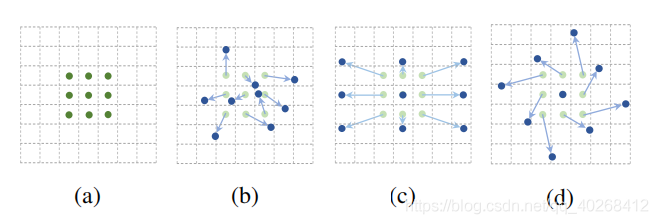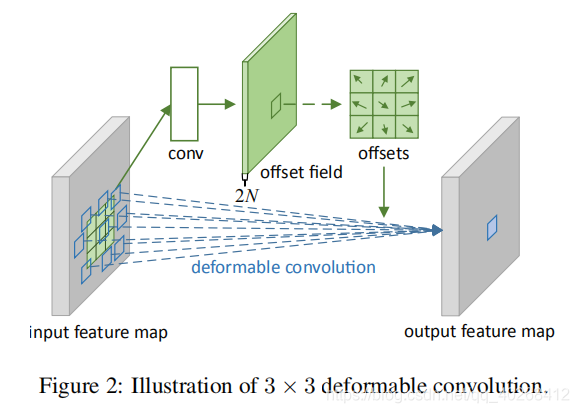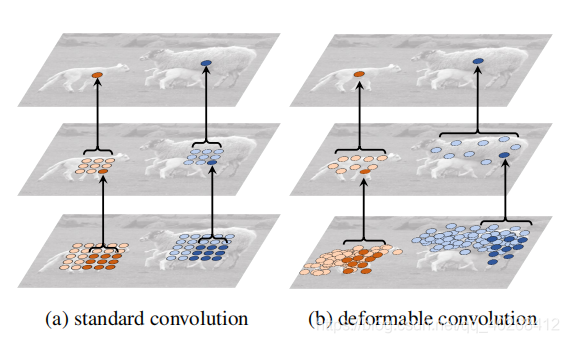The concept of deformable convolution was proposed in the paper: deformable convolutional networks
in this paper as the name suggests, deformable convolution is derived from the concept of standard convolution. In standard convolution operation, the convolution core’s action area is always in the rectangular area of the size of the standard convolution core around the center point (as shown in figure a below), while deformable convolution can be an irregular area (as shown in Figure B, C, D below, where the offset of B is random; C, D are special cases).

The implementation method of deformation convolution is shown in the following figure:

The dimension information of each part is as follows:
input feature map: (batch, h, W, c)
output feature map: (batch, h, W, n)
offset field: (batch, h, W, 2n)
offset field is obtained by standard convolution operation on the original graph, and the number of channels is 2n, which means n 2-dimensional offsets
(
△
x
,
△
y
)
(△x,△y)
(△ x, △ y), n is the number of convolution kernels, that is, the number of channels of output characteristic layer. The process of deformation convolution can be described as follows: firstly, standard convolution is performed on the input feature map to obtain n 2-dimensional offsets
(
△
x
,
△
y
)
(△x,△y)
(△ x, △ y), and then modify the values of each point on the input feature map (let feature map be
P
P
P. Namely
P
(
x
,
y
)
=
P
(
x
+
△
x
,
y
+
△
y
)
P(x,y)=P(x+△x,y+△y)
P (x, y) = P (x + △ x, y + △ y), when
x
+
△
x
x+△x
When x + △ x is a fraction, bilinear interpolation is used
P
(
x
+
△
x
,
y
+
△
y
)
P(x+△x,y+△y)
P(x+△x,y+△y))。 Form n feature maps, and then use n convolution kernels to convolute one by one to get the output.
The calculation results of standard convolution and deformation convolution are shown in the following figure:

Read More:
- tf.layers.conv1d Function analysis (one dimensional convolution)
- DHCP principle and experimental verification
- RPC principle and related technologies used
- Principle and usage of feof ()
- Introduction to the principle of Mali tile based rendering
- Tensorflow UnknownError (see above for traceback): Failed to get convolution algorithm. This is pro
- Solution to the incomplete display of the principle icon number exported by smartpdf in Ad
- RuntimeError: Unable to find a valid cuDNN algorithm to run convolution
- The function of flatten layer in deep learning
- CUBLAS_STATUS_ALLOC_FAILED
- RuntimeError: Expected hidden[0] size (x, x, x), got(x, x, x)
- “Typeerror: invalid dimensions for image data” in Matplotlib drawing imshow() function
- Error using ones Size inputs must be integers. Error in testdisplay1 (line 38) array=-ones(buf+m*(s
- Deep learning: derivation of sigmoid function and loss function
- Derivation process of gradient descent method based on house price
- In chome browser, console reports an error but does not display it
- The usage of Matlab function downsample
- sklearn.metrics.mean_squared_error
- Two dimensional array and pointer to one dimensional array